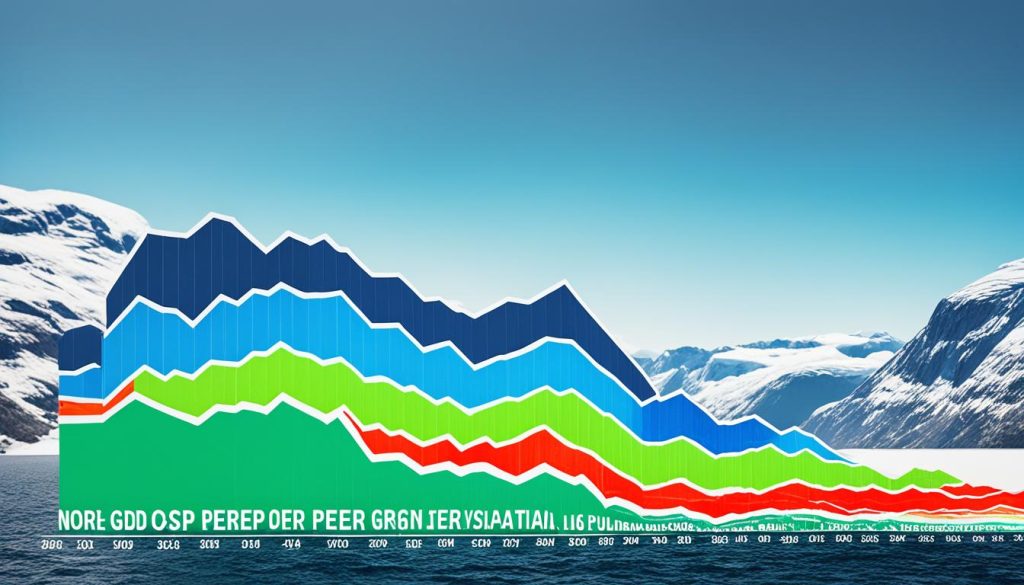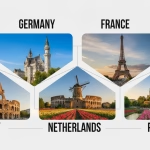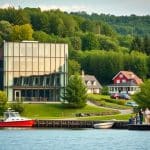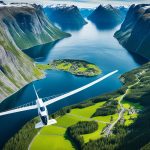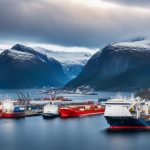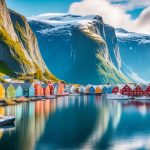“The nation that destroys its soil destroys itself.” – Franklin D. Roosevelt
Norway is known for its high GDP per capita. It is a prime example of economic stability and human growth. By wisely using its natural resources, Norway has built a strong and wealthy economy.
This country always scores high on the Human Development Index. This shows how its wealth also brings better living conditions for its people.
Norwegian economic history is filled with steady growth and careful planning. The story mixes technology with important social policies, rooted in Nordic traditions. This makes Norway important in world economic talks.
Natural resource management is crucial in Norway’s success. It matches the larger Nordic model of prosperity.
Key Takeaways
- Norway boasts an extraordinarily high GDP per capita.
- The country consistently ranks highly on the Human Development Index.
- Strategic natural resource management is central to its economic stability.
- Technological adoption and socio-economic planning are key factors.
- Norway serves as a global benchmark for prosperity and well-being.
An Overview of Norway’s Economic Stability
Norway’s economic history is a tale of stability. Its wealth began to grow long before oil and gas were found. The nation has seen strong growth rates since the 1800s. It has stayed strong through many global economic changes.
Norway became wealthy because it embraced new technology and trained its people well. Being adaptable has helped its economy grow. It has made the country’s financial base strong.
Old national accounts show how Norway’s GDP grew over time. These records show strong economic foundations existed well before oil wealth. They prove Norway has long been capable of steady growth.
In the end, Norway’s steady economy shows how well it uses resources and grows economically. Because of this, Norway remains one of the world’s wealthiest nations.
Historical Context: Norway’s Path to Wealth
Norway’s economic story is one of remarkable change and growth. Before becoming independent, the country mainly relied on farming, fishing, and sea trade. These industries were crucial, as many people depended on them to live and trade.
After 1814, Norway’s economic scene began to transform. The end of the Napoleonic Wars led to recession and money problems. Yet, the founding of the Central Bank of Norway and starting to use gold as money helped. These actions helped stabilize the economy and prepared for future growth.
The shift to becoming more industrialized really took off after 1905. This move was key in Norway’s economic story. Developing hydroelectric power was vital, driving further growth and building a solid base for gathering wealth.
In short, Norway went from being pre-independent to being a wealthy nation in a well-planned way. This growth after 1814, with important institutions and industrial progress, shows how Norway reached its economic success.
The Role of Natural Resources in Norway’s Prosperity
Norway’s wealth is deeply rooted in its natural resources like oil, gas, fish, and timber. These have played a big part in the country’s economic growth. They help sustain Norway’s development.
Significance of Oil and Gas
The North Sea’s oil was found in the 1960s. It changed Norway’s economy forever. Oil and gas are still key to its financial success today. The Government Pension Fund Global manages the oil income well. This ensures Norway’s wealth lasts for future generations.
Utilisation of Fish and Timber
Fishing has always been important to Norway, supporting both local and overseas markets. Timber, too, is vital, thanks to Norway’s large forests. Using fish and timber wisely helps Norway grow sustainably. It also helps diversify its economy.
Human Development Index: A Testament to Norway’s Success
Norway ranks top on the Human Development Index (HDI). This reflects its high life quality, education, and well-being. Norway stands out due to its investment in people and social services.
Norway’s HDI success comes from multiple factors. High education and strong healthcare improve life span. The government’s development efforts mean wealth benefits everyone.
Comparative Analysis with Other Countries

Norway’s HDI rank is high. It uses wealth from natural resources well, investing in education and health. This leads to longer lives and better education for its people.
Factors Contributing to High HDI Scores
Norway’s HDI is high because of:
- Life Expectancy: Its healthcare system makes Norway one of the healthiest countries.
- Education Level: Norway values education highly, seen in its quality schools and universities.
- Social Infrastructure: Its social services ensure a high living standard and societal well-being.
These factors show Norway’s effective leadership and dedication to socio-economic growth.
Economic Phases: Pre and Post-Independence from Denmark
Before breaking free from Denmark in 1814, Norway’s economy mainly focused on farming, fishing, and maritime trade. This economy was steady but faced challenges growing due to economic upheavals and reliance on foreign trade roads.
After gaining independence, Norway saw great changes and growth. This new phase brought an economic boost, driven by industrialisation and new technologies. Key sectors like hydroelectric power grew fast. This helped agriculture become much more productive, leading to big economic improvements.
Norway’s economic story is one of overcoming challenges and embracing change. By moving through tough times and embracing new industrial opportunities, Norway has achieved continuous economic growth. It stands today as a shining example of wealth and development.
The Impact of Technological Advancements
Norway’s economic scene has hugely benefited from embracing new technologies. It has boosted productivity. This progress has helped modernise different sectors. Investments in new technologies have improved traditional and new industries.
Adoption of Modern Technology in Various Sectors
Norway has grown economically by integrating modern technology across various sectors. Industries like fisheries, energy, and manufacturing have seen big changes. They’ve adopted new solutions. This has made processes smoother, improved efficiency, and sparked innovation. Such changes show Norway’s ambition to stay ahead globally.
Role of Education and Innovation
A strong education system supports Norway’s economic plans. It creates a skilled workforce that can modernise sectors. Norway’s education is known for its high quality. It emphasizes on technology trends. Innovation and education together drive economic growth.
The mix of technology and a strong focus on education makes Norway’s economy special. It pushes limits and sets new global standards for modernisation.
Social Democratic Rule and Economic Planning
In Norway, social democracy deeply influences society. It aims for fair wealth sharing and everyone’s well-being. The country’s economic planning is key. It follows the Nordic model, blending free markets with strong social policies.
The Nordic Model
The Nordic model is unique. It combines welfare with freedom and economic strength. Norway prospers, valuing both economy and society equally. Strategic government actions and investment in services like healthcare boost its robust economy.
Public Sector Contributions
Norway’s public sector plays a crucial role. It greatly supports both society and economy. By focusing on healthcare, education, and welfare, it ensures all share in the nation’s success. Such a strategy promotes growth and everyone’s well-being.
Norway’s Position in Global Economic Rankings
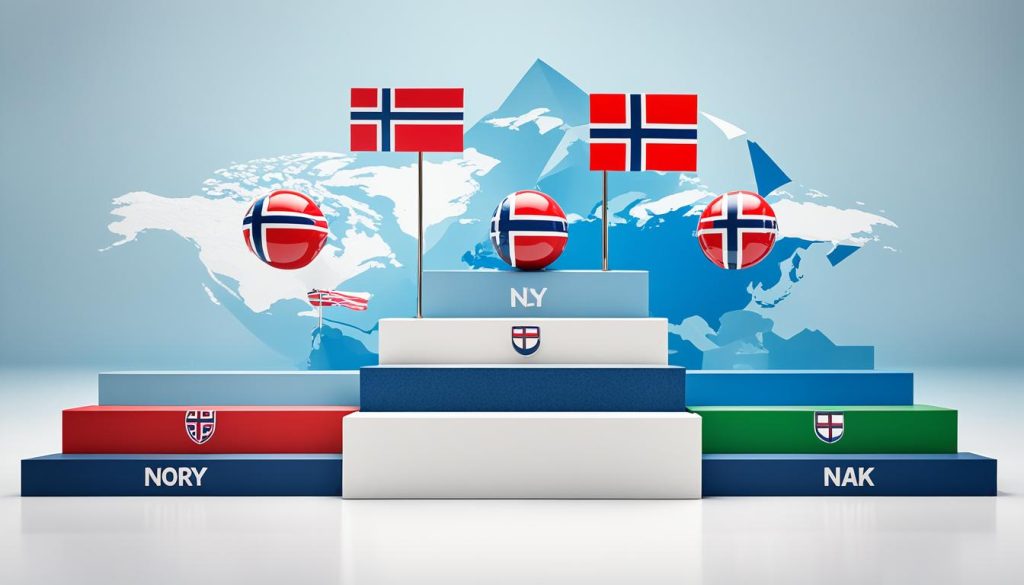
Norway is well-known for having a strong and stable economy. It often stands out in international rankings. This is because of careful economic planning and good governance.
Gross Domestic Product (GDP) Insights
Norway’s impressive GDP is key to its high global rank. The country has wisely used its natural resources, like oil and gas. Its innovative economic policies have also played a part.
Thanks to this, Norway has seen steady GDP growth. This growth helps ensure Norwegians enjoy a high standard of living.
Purchasing Power Parity (PPP) Analysis
PPP is another area where Norway shines. It shows Norwegians can buy more goods and services than people in many other places. Norway’s strong PPP figures highlight its economic success.
This signifies a high quality of life in Norway. It shows how well the country uses its resources and governs.
The Importance of a Skilled Labour Force
Norway’s economic success comes from its highly skilled workers. The nation’s focus on education means its people can handle complex tasks. They work well in different fields. Norway’s specific training programmes make sure its workforce stays sharp and flexible in a fast-changing world market.
Education encourages a culture of ongoing learning and excellence. This leads to better productivity. Norway’s skilled workforce pushes the country forward, keeping it competitive globally.
Norway combines education with job training to boost employment quality. This is key for its economy to grow. Such a focus helps businesses flourish and stand strong against world economic troubles. It places Norway high in the running among global markets.
Significance of International Trade to Norway
Norway’s economic success owes much to its trade. Historical and modern partnerships boost its growth. The nation uses its strategic position and rich resources well in global trade.
Historical Trade Partnerships
Norway has a celebrated maritime history. Its robust seafaring and shipping industries opened vital trade routes. This helped Norway trade goods like fish and timber, building lasting partnerships.
Modern Trade Relations
Now, Norway is growing and diversifying its trade. It shows commitment by signing free trade agreements and joining international forums. The country’s trade policies now focus on exporting innovative products and natural resources. This showcases Norway’s dynamic economy and forward-thinking trade strategies.
Norway’s Banking and Financial Institutions
Norway’s banks are known for their strong management. At the core of this strength is the Central Bank of Norway. It’s crucial in keeping the country financially stable. The Central Bank’s start was a big step for Norway’s economy, guiding its financial path wisely.
The Formation of the Central Bank of Norway
The Central Bank of Norway began in 1816. It was key in making the economy stable after Norway became independent. The bank was set up to manage money and ensure the country had a good economic base. Over the years, it’s adjusted to new economic challenges, keeping Norway’s financials steady and dependable.
Monetary Policies and Economic Impact
Norway plans its monetary policies to keep the economy strong. The Central Bank uses different strategies to keep money stable. For instance, it adjusts interest rates and works to keep inflation in check. These actions help the economy stay healthy and build trust in Norway’s financial systems. This trust contributes to long-term economic stability.
Effects of Stagflation and Inflation Periods
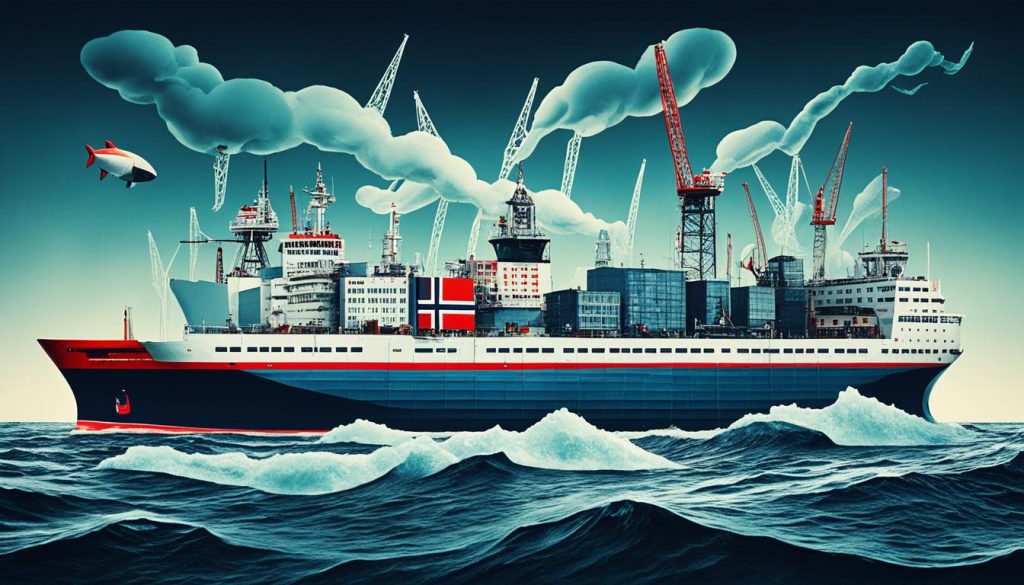
Norway has faced stages of stagflation and inflation. The government had to adjust the economy carefully. They used special measures to keep the economy stable.
Stagflation hit Norway hard at times. The government had to act tough. They used policies to fight inflation and boost the economy.
Norway has always focused on keeping prices stable. They rely on strong monetary policies. This approach helps them manage inflation with little harm to the economy.
The Role of Maritime Services in Norway’s Economy
Norway’s maritime history is crucial to its economy. Since early times, Norway has been a leader at sea. The Norwegian shipping industry has evolved with new technology and global trade. This ensures Norway plays a key role on the world stage.
Historic Maritime Power
Norway has always been a major maritime power. Its long coastline and strategic spot helped grow a strong shipping industry. Norway became a top maritime nation through advanced shipbuilding and excellent navigation skills. Its economy thrives on maritime trade and fishing thanks to these efforts.
Transition from Sail to Steam Vessels
The change from sail to steam ships marks a key point in Norway’s maritime history. This change boosted the Norwegian shipping industry’s efficiency and global presence. Norway stayed ahead in global shipping by smoothly moving to steam technology. This helped its economy stay strong and diverse.
Government Policies Promoting Economic Stability
Norway’s economic health benefits greatly from careful government actions. They have implemented a strong tax system and focus on spending money wisely. This smart management supports the country’s economy and boosts public spending.
Taxation and Fiscal Health
At the heart of Norway’s financial plans is a fair and effective tax system. It helps keep the money flowing steadily, important for managing the country’s finances. Strict tax rules and their enforcement ensure everyone pays their share, helping keep Norway strong.
Government Spending
Norway also watches how it spends its money very closely. They make sure money goes to important areas like health, education, and roads. This careful planning helps grow the economy and maintains a stable future by creating a better place for everyone.
Industries Driving Norway’s Economic Growth
Norway’s economy is strong, thanks to key industries. Hydroelectric power and manufacturing lead the way. Both have grown a lot and are also innovative. Norway focuses on being green. This makes sure these sectors do well while being kind to the planet.
Hydroelectric Power and Manufacturing
Hydropower is big in Norway. It uses a lot of water to make clean energy. This makes Norway a leader in green energy. The manufacturing sector is also growing. It uses new technology and has been growing steadily. This helps Norway’s economy a lot.
Emphasis on Sustainable Development
Norway is serious about being green. It mixes environmental care into industry work. This helps keep energy use sustainable. It makes sure Norway stays a leader in being eco-friendly. As industries like hydropower and manufacturing grow, they keep using green methods. This sets an example for the world.
Factors Behind Norway’s Low Unemployment Rates
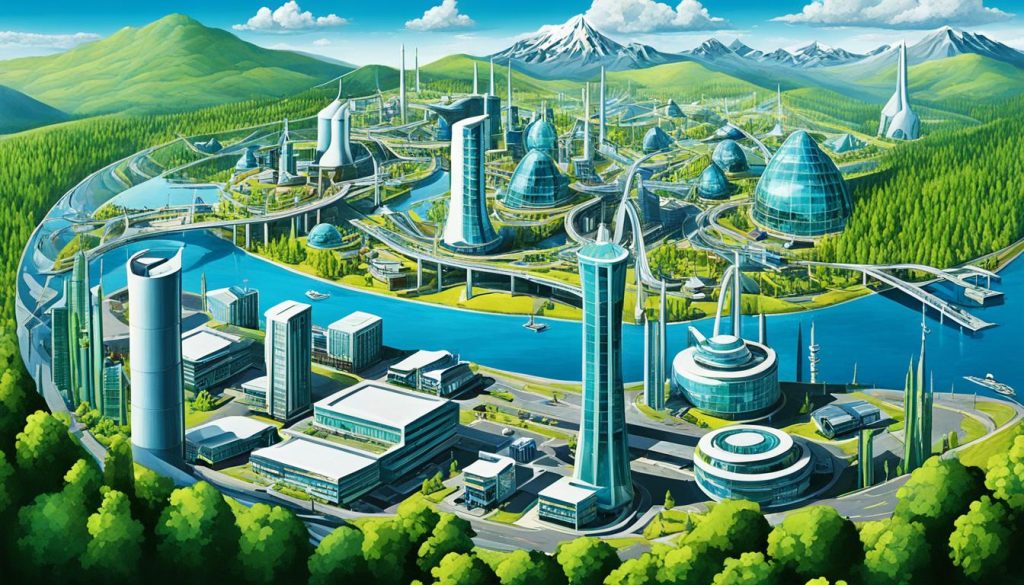
Norway has a very low unemployment rate. This is due to effective employment policies and strong job strategies. They link education with industry needs, making sure people are ready for jobs.
Norway’s economy is active, thanks to forward-thinking employment measures. They focus on re-skilling and up-skilling workers. This helps people keep up with changing job markets.
- Comprehensive job creation strategies tailored to emerging industries
- Continuous evaluation and enhancement of employment policy frameworks
- Strategic efforts to mitigate unemployment factors through supportive programmes
The combination of these efforts keeps Norway’s job market strong. It helps maintain high employment rates across various industries. Norway sets an example of how to keep unemployment low worldwide.
Norway’s Energy Production and Exports
Norway’s energy sector is key to its economy, driven by oil exports and green energy. The country excels in producing energy, mainly from oil. At the same time, it’s moving towards renewable sources. This shift aims for a balanced energy mix and a sustainable future.
Oil Exploration and Exportation
Oil is at the heart of Norway’s energy industry. The 1960s saw huge oil finds in the North Sea. These finds boosted Norway’s economy. The Government Pension Fund Global shows Norway’s wise oil income use. It helps the economy handle oil price changes well.
Renewable Energy Initiatives
Renewable energy is rising in Norway, showing its commitment to the planet. The country invests in hydropower, wind, and solar energy. These efforts aim to lessen environmental impact. They also secure Norway’s role as a clean energy leader.
The Importance of Judicial Effectiveness and Government Integrity
Norway’s judicial system is key to its stability and prosperity. Its efficiency and governance integrity are vital for public and business confidence.
Property Rights Protection
At its core, Norway’s judicial system strongly protects property rights. This assurance enables people and companies to invest without worrying about unfair loss. It creates a growth-friendly atmosphere.
Legal Framework and Enforcement
Norway’s governance relies on solid legal frameworks and strict enforcement. These elements ensure justice, counter corruption, and boost transparency. They build trust among local and global partners, showcasing Norway’s commitment to good governance.
Overall, secure property rights and strict law enforcement form the backbone of Norway’s economic success. These judicial system traits boost confidence domestically and elevate Norway on the world stage.
Key Takeaways: Why Norway is Known for Its Stable Economy
Norway’s economy is admired for mixing smart use of resources with strong social policies. This approach has led to steady growth, making the country a success story. Norway shows us how to prosper by caring for both its people and its natural riches.
Managing natural riches well is key to Norway’s strategy. The country has lots of oil, fish, and wood. It uses these wisely to keep growing. This smart management is a big reason for Norway’s overall success.
Norway also focuses on its people’s skills. It invests in education and new tech. This creates a smart and inventive workforce. These efforts keep Norway’s economy strong and competitive worldwide.
- Technological and educational progression.
- Judicious management of natural resources.
- Resilient institutions and equitable social policies.
Norway’s stable economy also depends on its fair institutions and social policies. These ensure everyone benefits from the economy. This has made Norway a model for how countries can thrive. It offers lessons for the world on building a strong, fair economy.
Future Prospects for Norway’s Economic Stability
Norway’s economy looks very strong, thanks to its solid foundation and smart handling of resources. The country is ready for more growth, thanks to its sustainable and innovative ways. Norway is investing in new areas like renewable energy and technology. This shows it’s planning well for the future and aims to stay a leading global economy.
Norway focuses on being sustainable, which is good for both the environment and the economy. It’s working hard to lower its carbon emissions and support green tech. This not only helps Norway grow but also makes it a world leader in sustainable development. By caring about the economy and the environment, Norway stays strong against global economic changes.
Investing in Norway is very appealing because of its stable rules and talented workers. The country is all about innovation and attracting investors from around the globe. This is boosting its economy even more. With its strengths and new chances, Norway’s future looks very bright. It’s set for a future filled with wealth and stability.

